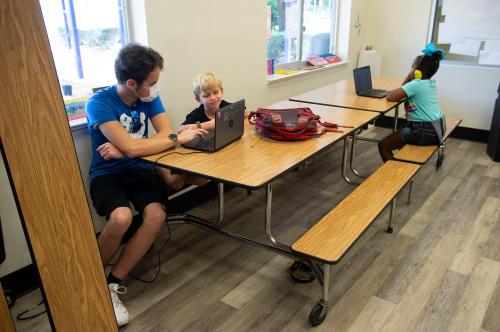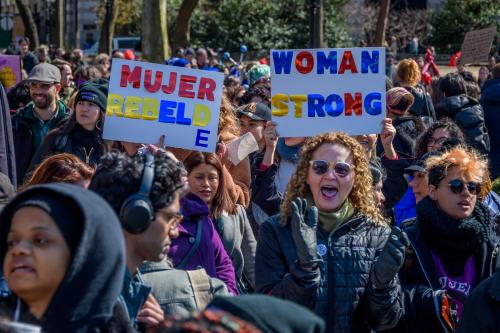If you want more content like this, subscribe to our newsletter.
This week in Class Notes:
-
- Our own Bill Gale and colleagues describe intergenerational wealth trends, with a special focus on millennials.
- Salary history bans reduce the gender pay gap.
- Placing sanctions on poorly-performing for-profits helps redirect students to community colleges, where they are less likely to default on federal student loans.
- Our top chart shows that Hispanic and Black workers are experiencing disproportionately high unemployment rates due to COVID-19.
- Kim Brooks argues for paying mothers for child care.
- Finally, check out our colleague Sarah Reber and Nora Gordon’s new piece on how the federal government can best support students in the time of COVID-19
The wealth of generations, with special attention to the millennials
Gale et al. document household wealth trends across birth cohorts and over time, with a particular focus on millennials. They show that although the Great Recession reduced wealth in every age group, the wealth of older age groups has increased when considering a longer time frame, while the wealth of younger age groups has declined. The median level of wealth of millennials in 2016 was lower than that of any similarly-aged cohort between 1989 and 2007. Millennials will have some advantages in wealth accumulation relative to previous generations, including more education and longer working lives. But they face many disadvantages too, including weak prospects for economic growth and delays in home purchase and marriage. The millennial generation also contains a significantly higher percentage of minorities than previous generations; minority households have tended to accumulate less wealth than whites in the past, and the difference appears to be growing over time for Blacks relative to whites. Importantly, these trends pre-date the COVID-19 pandemic.
Information and the persistence of the gender wage gap: Early evidence from California’s salary history ban
In an effort to reduce the gender wage gap, several states have recently adopted legislation that prohibits employers from asking about previous salaries. Advocates of these salary history bans (SHBs) argue that information about pay history perpetuates past discrimination. Hansen et al. study the preliminary effects of the first state-wide SHBs and find that the ratio of women’s earnings relative to men’s increased by 1% in states with SHBs. The increases were largely driven by a narrowing of the gender earnings gap among workers over 35, employees who had recently switched jobs, and workers in households with school-age children (i.e. over 5 years old).
Where do students go when for-profit colleges lose federal aid?
After more than a decade of substantial growth, for-profit higher education has become the target of increased scrutiny due to high student loan default rates, accusations of unethical marketing practices, and allegations of financial aid fraud. Under the Obama administration, the U.S. Department of Education sought to restrict access to federal student aid at for-profit colleges where graduates had high student loan payments and low earnings. Cellini et al. examine the effects of these sanctions. The authors find that sanctioned for-profits experienced a 68% decrease in annual enrollment; these losses were largely offset by increased enrollment at local community colleges, where students are less likely to default on federal student loans. Additionally, the imposition of the sanctions decreased enrollment in local unsanctioned for-profit competitors, likely because of improved information about local options and the reputation of these types of institutions. (Note: these regulations have been significantly softened by the Trump administration.)
Top chart
This week’s top chart shows that Hispanic and Black workers have experienced the largest upticks in unemployment due to the coronavirus recession. In April, the unemployment rate of Hispanic workers surged to 18.9%, an all-time high, while Black unemployment rose to 16.7%, surpassing the White unemployment rate of nearly 15%.

Choice opinion
“In our country, staying home to raise children is one of the most devastating financial decisions a woman can make…Parents, particularly mothers, become poorer because they are not properly compensated for the contribution they’re making to the continuation of society by bearing and raising children. What exactly is the value of this contribution? The birthrate in the United States has fallen to a record low of 1.73. People who complain that other people’s children shouldn’t be their concern will still have to deal with the economic catastrophe of an aging population and a shortage of young, healthy workers. If raising these future citizens isn’t socially necessary labor, I’m not sure what is,” writes Kim Brooks in The New York Times.
Self-promotion
The coronavirus pandemic has upended business as usual for the nation’s elementary and secondary schools. Given the budget shortfalls state and local government now face, schools will need a large infusion of federal funds if they are to address students’ growing needs. What options does the federal government have for getting money where it is most needed? The details of the approach taken will have a significant effect on the distribution of funds and how schools can spend it. In their new piece “Supporting students and promoting economic recovery in the time of COVID-19”, Sarah Reber and Nora Gordon explore the trade-offs Congress will need to weigh when choosing how best to support students amid the COVID-19 crisis.
The Brookings Institution is committed to quality, independence, and impact.
We are supported by a diverse array of funders. In line with our values and policies, each Brookings publication represents the sole views of its author(s).








Commentary
Class Notes: Millennial wealth accumulation, salary history bans, and more
Wednesday, May 20, 2020